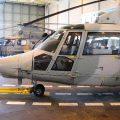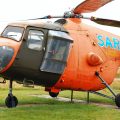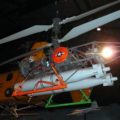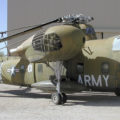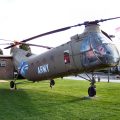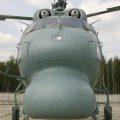
| Piasecki HUP Retriever | |
|---|---|
| Kraju | Stany Zjednoczone Ameryki |
| Roli | Śmigłowiec użytkowy |
| Pierwszy lot | Marzec 1948 r. |
| Zbudowany | 339 |
Tthe Piasecki H-25 Army Mule/HUP Retriever – kompaktowy, pojedynczy silnik promieniowy, dwunakładowy śmigłowiec tandemowy opracowany przez Piasecki Helicopter Corporation of Morton w Pensylwanii pod koniec lat 40. Firma zmieniła nazwę w 1956 roku na Vertol Aircraft Corporation, a następnie została kupiona przez Boeing Aircraft Company w 1960 roku i stała się Boeing-Vertol.
| Piasecki HUP-3 (H-25A) Spacer retriever | |
|---|---|
| Fotograf | Władimir Yakubov |
| Lokalizacja | Pima Muzeum Powietrza i Przestrzeni Kosmicznej, Tuscon |
| Zdjęcia | 27 |
Podobne zestawy:
| Piasecki HUP-2 Spacer dookoła | |
|---|---|
| Fotograf | Niewiedzy |
| Lokalizacja | Niewiedzy |
| Zdjęcia | 32 |
Znajdź zestawy w serwisie eBay:
The Piasecki HUP Retriever was a twin-rotor utility helicopter developed by Piasecki Helicopter in the late 1940s for the United States Navy, Army and Coast Guard. It was designed to meet a Navy requirement for an all-purpose helicopter capable of shipboard operations, cargo transport, air-sea rescue, and reconnaissance. The HUP Retriever had a distinctive tandem-rotor configuration with a front rotor that tilted up for increased lift and a rear rotor that tilted down for anti-torque. The helicopter had a crew of two and could carry up to four passengers or 1,000 lb (450 kg) of cargo in a spacious cabin. The HUP Retriever was powered by a single Continental R-975 radial engine mounted in the rear fuselage and driving both rotors through a complex transmission system. The helicopter had a fixed tricycle landing gear and a tailwheel that could be retracted for shipboard operations.
The HUP Retriever first flew in March 1948 and entered service with the Navy in 1949. It was also adopted by the Army as the H-25 Army Mule and by the Coast Guard as the HUP-1. The helicopter proved to be versatile and reliable, serving in various roles such as anti-submarine warfare, search and rescue, liaison, and training. The HUP Retriever was also deployed to Korea and Vietnam, where it performed admirably in harsh conditions. The helicopter was gradually replaced by more advanced models such as the H-34 Choctaw and the UH-1 Iroquois in the 1960s. A total of 339 HUP Retrievers were built, of which some are preserved in museums today.
Liczba wyświetleń : 1560

